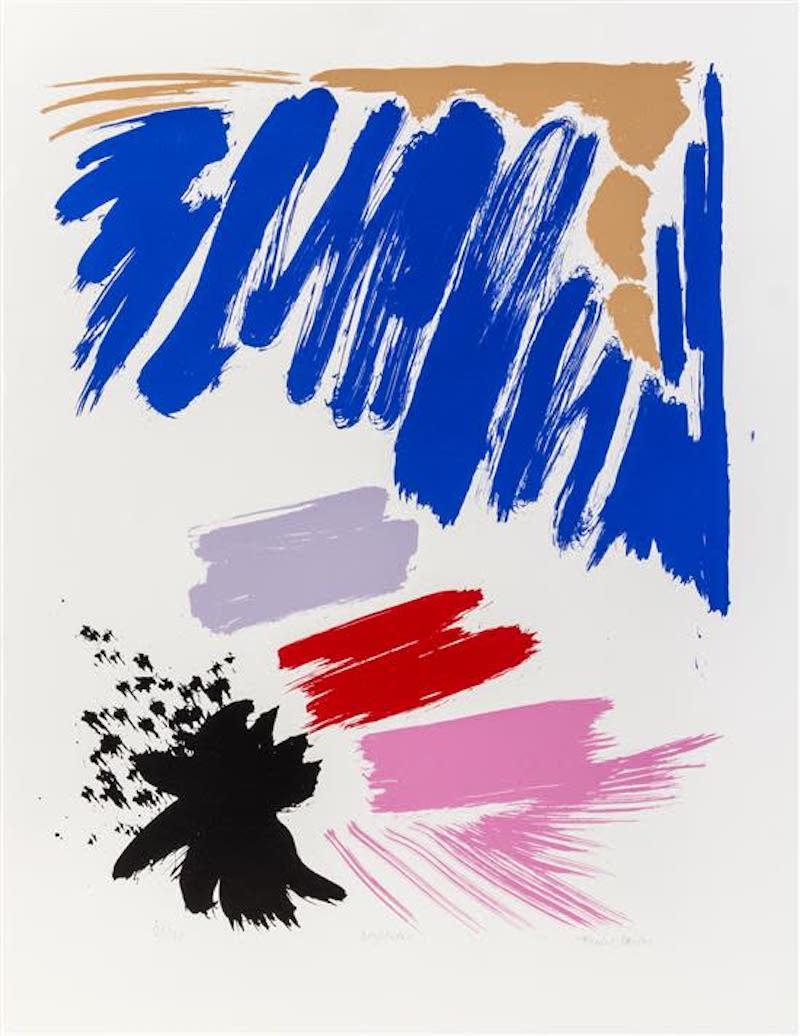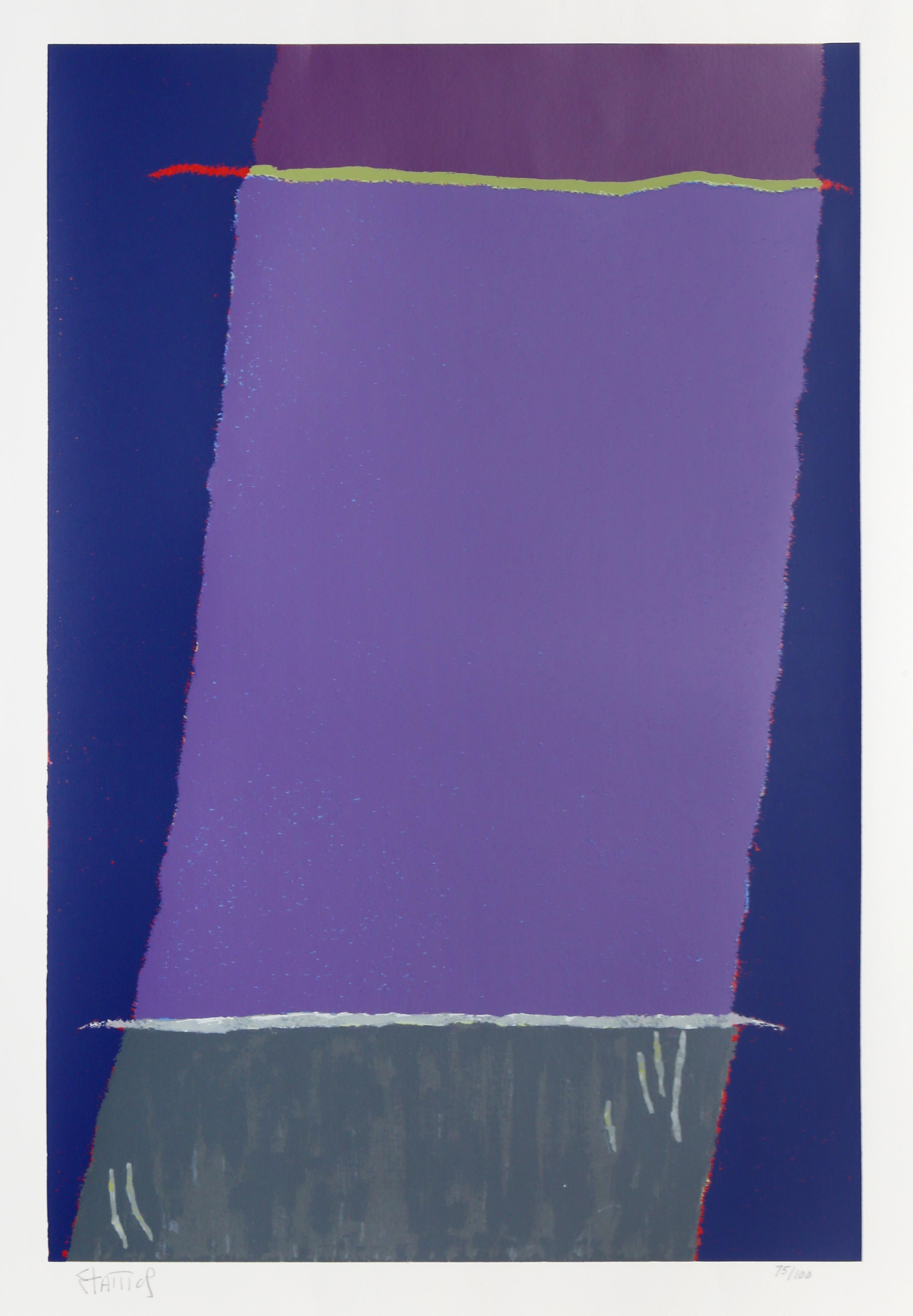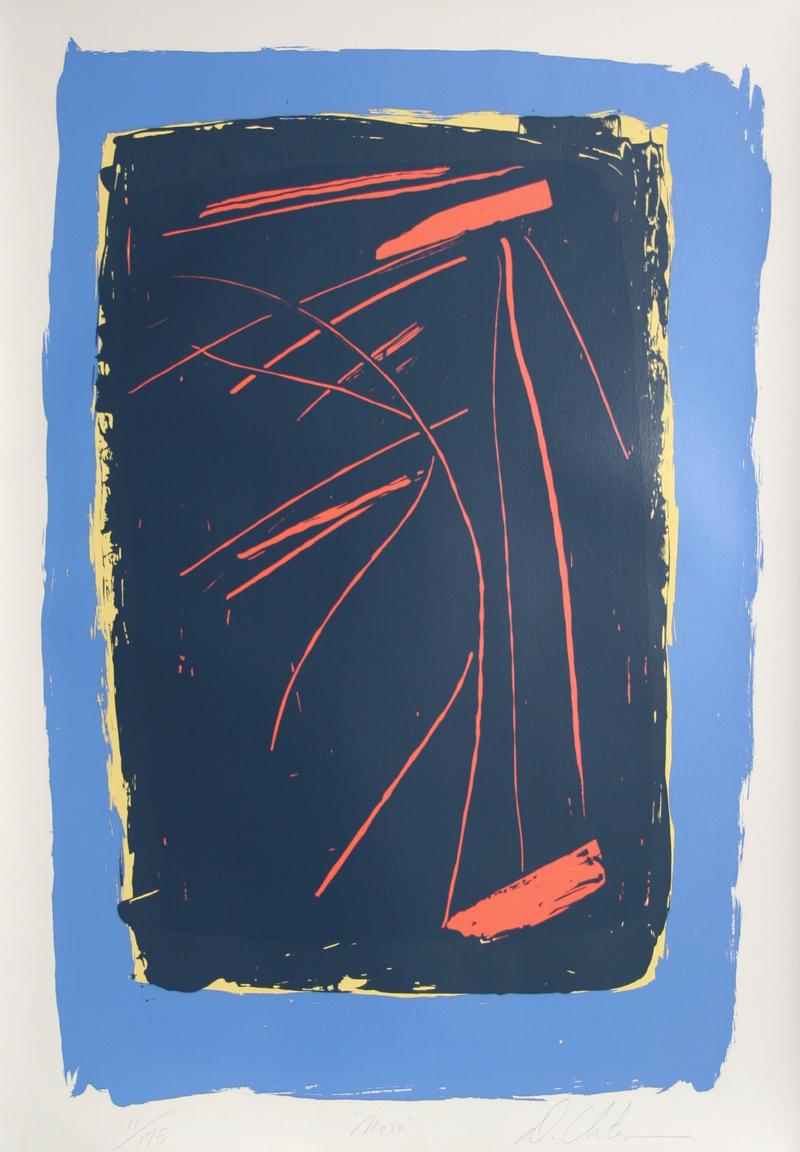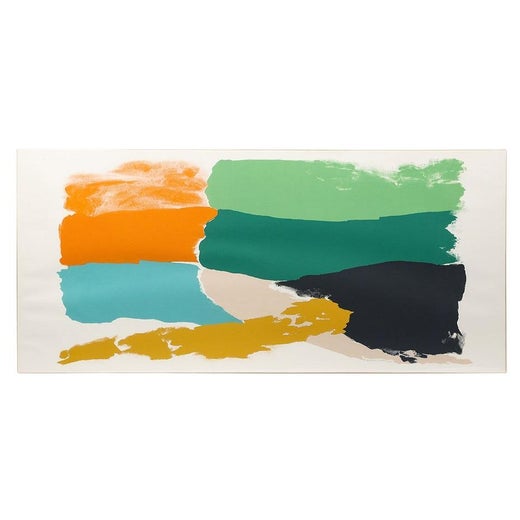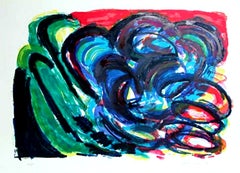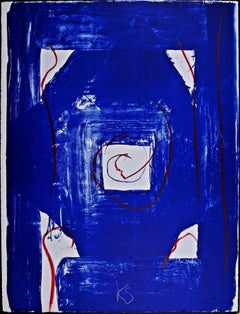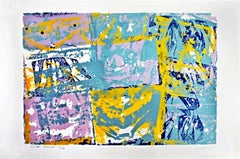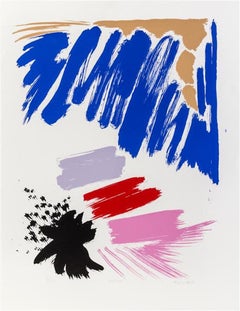Items Similar to Friedel Dzubas Night Star Abstract expressionist color field silkscreen signed/N
Want more images or videos?
Request additional images or videos from the seller
1 of 9
Friedel DzubasFriedel Dzubas Night Star Abstract expressionist color field silkscreen signed/N1984
1984
$2,800
£2,097.32
€2,424.39
CA$3,932.08
A$4,282.67
CHF 2,266.67
MX$52,399.82
NOK 28,048.22
SEK 26,475.79
DKK 18,095.12
About the Item
Friedel Dzubas
Night Star, 1984
Silkscreen on wove paper with deckled edges
Pencil signed and numbered 24/90 on the front
32 3/10 × 19 1/10 inches
Unframed
Terrific silkscreen by renowned color field artist Friedel Dzubas. Hand signed and numbered on the front.
Friedel Dzubas Biography
In a vibrant career spanning five decades, German-born American painter Friedel Dzubas (1915–1994) created an extensive body of work featuring exquisitely counterpoised brushed color shapes. Early on, Dzubas was associated with a group of second-generation abstract painters who in the later 1950s had turned from broad gestural strokes of thickened impasto in overlapping abstract formations to floating or merging shapes and planes made with thinned pigment that allowed color to become the primary expressive element. Yet, unlike several painter colleagues who stained their diluted pigments into raw canvas, Dzubas activated his surfaces with juxtaposed and crossing forms that felt embodied, full, and which seemed to stand up on the surface, because painted over gesso grounds. It was not until the middle 1960s that Dzubas began to use acrylic paint—a full decade after others had turned to synthetic colors. But for a small series of paintings on bedsheets in 1957–58 and a group of “black drawings” using oil paint created between 1959 and 1962, Dzubas never sought the effect of pigment melding with raw cotton duck even as he continued the “field” painting of Rothko and Newman, applying paint over his grounds in a thin, texturally uniform manner. His later work can be characterized by an effect he called “washing out,” a feathering technique that propels his color forms across the extraordinary lateral expanses of canvases extending from eighteen to twenty-three feet. His magnum opus, Crossing, Apocalypsis cum Figuras, 1975, expands to nearly sixty feet. Working in a large scale allowed Dzubas to realize his equally large vision for color abstraction.
Dzubas was an autodidact, never having undergone formal training in painting. Considered a Mischling (a child of mixed-race parents, a Jewish father and a Catholic mother) and thus denied the opportunity to go to university, at the age of fifteen he was apprenticed to a wall decorations firm in Berlin. Nazi hegemony also constrained his exposure to historic and contemporary artwork until his emigration to America in 1939. For several years after his arrival in America, Dzubas carried on the work of his German uncles and cousins by engaging in free-lance book design, first in Chicago and then in New York. By the late 1950s, he was able to paint full-time.
With gallery representation in America (Leo Castelli, Robert Elkon, Lawrence Rubin, Knoedler, and André Emmerich in New York, Nicholas Wilder in Los Angeles, Meredith Long in Houston, among others); the United Kingdom (Kasmin, Ltd. in London); Canada (David Mirvish Gallery in Toronto); and Germany (Hans Strelow) in the 1960s and 1970s, Dzubas’s career was assured. He left New York City in 1967 for a full-time teaching position at Cornell University, and then moved to Cambridge, Massachusetts as Visiting Artist at the School of the Museum of Fine Arts in Boston from 1976 to 1983. Dzubas’s monographic retrospectives include The Museum of Fine Art, Houston (1974); The Museum of Fine Arts, Boston (1975); Kunsthalle Bielefeld, Bielefeld, Germany (1977), The Hirshhorn Museum and Sculpture Garden (1983); a retrospective exhibition at André Emmerich Gallery, New York (1990); and the Museum of Art, Fort Lauderdale, Florida (1991).
-Courtesy Yares
- Creator:Friedel Dzubas (1915-1994, German)
- Creation Year:1984
- Dimensions:Height: 32.3 in (82.05 cm)Width: 19.1 in (48.52 cm)
- Medium:
- Movement & Style:
- Period:
- Condition:
- Gallery Location:New York, NY
- Reference Number:1stDibs: LU1745215137132
Friedel Dzubas
Friedel Dzubas was born April 20, 1915 in Berlin and studied at the Prussian Academy of Fine Art and under Paul Klee while in Düsseldorf from 1936 to 1939. In 1939, Dzubas fled Germany for London and the United States where he later became a citizen. In 1948, he he answered art critic Clement Greenberg's anonymous advertisement for a summer roommate. It was the height of the Abstract Expressionist Movement in New York, and through Greenberg Dzubas met Willem de Kooning, Jackson Pollock, Adolph Gottlieb and Barnett Newman. Later, in the early 1950s, Dzubas shared a studio with Helen Frankenthaler, associating with some of the younger generation of abstract painters in New York including Jules Olitski and Kenneth Noland. In the early 1950s, he began exhibiting his work in New York. In the 1960s, he started experimenting with color field painting. Dzubas' mature paintings since the 1960s assimilate his early interest in German Romanticism and Expressionism into post-war American abstraction. "He abandoned oil paint for Magna acrylic in 1965 when he found he could achieve with a brevity of gesture the brilliance and luminosity of oil paint applied in thin veils of color. He could thus effect the richness and variation of traditional glazed tones using a more expressive, immediate process. By the early 1980s, Dzubas abandoned his preliminary preparations of sketching and priming, thereby inviting spontaneity and accident into his painting process. Although he typically coated his canvas with a gesso primer before painting, he began to apply it so thinly that the pigment was almost immediately absorbed into the ground, making it impossible for him to revise and rework his compositions. Dzubas' change in technique reveals a thoroughly modernist sensibility: "I like that risk," he explained. "I think, to a certain degree, I have to make it mechanically difficult and unreliable for myself. If I can predict the effect too much, then I probably am not supposed to be doing it. I function better if my footing is not too sure, so to speak." The rich, velvety hues of Grade's reds, greens, and blues appear radiant in places. Dzubas heightened his color drama -- a drama characterized as quintessentially Baroque by some critics-- by varying the density of his paint. His rectangular forms appear to ebb and flow in an orchestrated movement across the surface of the picture plane." (Megan Bahr) A retrospective of Dzubas' work was shown at the Museum of Fine Art, Houston in 1974 and at the Museum of Fine Art, Boston the following year. In 1983, Dzubas was honored with an exhibition at the Hirshhorn Museum and Sculpture Garden, Washington, D.C. (ASKART)
About the Seller
5.0
Platinum Seller
Premium sellers with a 4.7+ rating and 24-hour response times
Established in 2007
1stDibs seller since 2022
450 sales on 1stDibs
Typical response time: 2 hours
- ShippingRetrieving quote...Shipping from: New York, NY
- Return Policy
Authenticity Guarantee
In the unlikely event there’s an issue with an item’s authenticity, contact us within 1 year for a full refund. DetailsMoney-Back Guarantee
If your item is not as described, is damaged in transit, or does not arrive, contact us within 7 days for a full refund. Details24-Hour Cancellation
You have a 24-hour grace period in which to reconsider your purchase, with no questions asked.Vetted Professional Sellers
Our world-class sellers must adhere to strict standards for service and quality, maintaining the integrity of our listings.Price-Match Guarantee
If you find that a seller listed the same item for a lower price elsewhere, we’ll match it.Trusted Global Delivery
Our best-in-class carrier network provides specialized shipping options worldwide, including custom delivery.More From This Seller
View AllDescription Without Place, abstract expressionist lithograph + silkscreen signed
By Claire Seidl
Located in New York, NY
Claire Seidl
Description Without Place (Hand Signed), 1986
Lithograph and silkscreen.
Hand signed, dated and numbered 17/65 by the artist.
28 × 38 1/2 inches
Unframed
Gorgeous Abstr...
Category
1980s Abstract Abstract Prints
Materials
Screen, Lithograph
Kimber Smith, Abstract Expressionist Geometric Abstraction signed/n lithograph
By Kimber Smith
Located in New York, NY
KIMBER SMITH
Untitled Abstract Expressionist Geometric Abstraction, 1967
Lithograph on Rives paper
25 × 19 3/5 inches
Signed in silver...
Category
1960s Abstract Geometric Abstract Prints
Materials
Lithograph
Sicilian Magician - lt ed silkscreen by renowned abstract expressionist Signed/N
By Walter Darby Bannard
Located in New York, NY
Walter Darby Bannard
Siciliian Magician, 1980
Silkscreen on wove paper
Pencil signed, titled and dated by the artist on the front
Unframed
Provenance: Bart Gallery, Providence, RI
Th...
Category
1980s Abstract Expressionist Abstract Prints
Materials
Screen
Jules Olitski, Mozart Night, color field silkscreen for Lincoln Center, Signed/N
By Jules Olitski
Located in New York, NY
Jules Olitski
Mozart Night, 1992
Silkscreen on wove paper
Signed, dated, titled and numbered 71/108 in graphite pencil on the front
Edition 71/108
47 × 36 inches
Unframed
Silkscreen ...
Category
1990s Abstract Expressionist Abstract Prints
Materials
Screen
5745, for the Jewish Museum original signed/n abstract expressionist screenprint
By Nancy Graves
Located in New York, NY
Nancy Graves
5745, for the Jewish Museum, 1984
Silkscreen on paper
Signed, numbered 5/90 and dated in graphite pencil on the front; bears publishers' blind stamp front left corner
30 1/4 × 40 1/2 inches
Unframed
Commissioned by the Mr. and Mrs. Albert A. List Graphic Fund for The Jewish Museum, New York
Signed, numbered and dated in graphite pencil on the front; bears publishers' blind stamp front left corner. Commissioned by the Mr. and Mrs. Albert A. List New Year's Graphic Fund for The Jewish Museum, New York. During the 1980s, various artists were commissioned to create a print celebrating the Jewish New Year. This is the silkscreen renowned sculptor Nancy Graves created to celebrate the year 5745 of the Jewish Calendar, beginning in September 1984 (Rosh Hashanah). This work was published in a limited edition of 90. The number 90 has special significance in Jewish gamatria (numerology) for several reasons, including the fact that it equals five times life - or Chai. The number for Chai, meaning "Life " s 18, and 18 x 5 = 90. This is a magical number in Judaism. All of the works were published in editions that were multiples of 18, or the Life. In her lifetime, Nancy Graves did not receive the renown or acknowledgement that her ex-husband and former Yale School of Art classmate Richard Serra did, but she is finally getting the recognition she richly deserves.
Biography: Nancy Graves (1939 – 1995) is an American artist of international renown. A prolific cross-disciplinary artist, Graves developed a sustained body of sculptures, paintings, drawings, watercolors, and prints. She also produced five avant-garde films and created innovative set designs.
Born in Pittsfield Massachusetts, Graves graduated from Vassar College in 1961. She then earned an MFA in painting at Yale University in 1964, where her classmates included Robert Mangold, Rackstraw Downes, Brice Marden, Chuck Close, as well as Richard Serra with whom she was married from 1964 to 1970. Five years after graduating, her career was launched in 1969 when she was the youngest artist — and only the fifth woman — to be selected for a solo presentation at the Whitney Museum of Art. Graves’ work was subsequently featured in hundreds of museum and gallery exhibitions worldwide, including several solo museum exhibitions. She was awarded commissions for large-scale site-specific sculptures and her work is in the permanent collections of major art museums. A frequent lecturer and guest artist, her work was widely documented during her lifetime. In 1991 she married veterinarian Dr. Avery Smith. Graves travelled extensively and was fully engaged with the cultural and intellectual issues of her times. Her brilliant career and life were cut short by her untimely death from cancer at age 54.
From a point of view that she described as “objective,” Graves transformed scientific sources, such as maps and diagrams, into artworks by re-producing their complex visual information in detailed paintings and drawings. Investigating the intersections between art and scientific disciplines, Graves created compelling, formally rigorous, yet ultimately expressive works of art that examine concepts of repetition, variation, verisimilitude, and the presentation and perception of visual information.
Based in SoHo, New York, Graves gained prominence in the late 1960s as a post-Minimalist artist for innovative camel, fossil, totem, and bone sculptures that were hand formed and assembled from unusual materials such as fur, burlap, canvas, plaster, latex, wax, steel, fiberglass and wood. Made in reaction to Pop and Minimalism, these works reference archaeological sites, anthropology, and natural science displays. Suspended from the ceiling or clustered directly on the floor, these early sculptures also engage with Conceptualist ideas of display. For her Whitney Museum presentation Graves exhibited three seemingly realistic sculptures of camels in an installation that evoked taxidermy specimens and questioned issues of verisimilitude in art and science, particularly in light of their hand patched and painted fur surfaces. The exhibition elicited wide spread critical responses and established her artistic significance.
After intensely engaging with sculpture in the early 1970s, Graves returned to painting. Her detailed pointillist canvasses re-produced — in paint — images culled from documentary nature photographs, NASA satellite recordings, and Lunar maps, commingling scientific exactitude with abstraction. Resuming sculpture in the late 1970s, Graves was among the first contemporary artists to experiment with bronze casting. She re-invigorated the traditional lost wax technique by assembling cast found objects into unique improbably balanced sculptures, with bright polychrome surfaces and distinctive patinas.
Throughout the 1980s Graves became widely recognized for her increasingly large and graceful open-form sculpture commissions. At the same time, she also expanded her drawing, painting, and printmaking practice and made large gestural watercolors. Then, in the late 1980s she created wall-mounted works that combined her explorations of sculpture, painting, form and color. In these large-scale pieces, she mounted high relief polychrome sculptural elements to the surfaces and edges of painted shaped canvases so that patterned shadows were cast onto the paintings and surrounding wall.
By the 1990s Graves was casting in glass, resin, paper, aluminum, and bronze, combining these varied materials and colors into daring sculptures with moving parts. As she proceeded in all the media she mastered, Graves increasingly re interpreted and transmuted forms sourced from her own earlier artwork — rather than from outside research — creating elaborate compositions that form a layered a-temporal archaeology of her own visual production.
Nancy Graves’ pioneering art...
Category
1980s Abstract Expressionist Abstract Prints
Materials
Graphite, Screen
Unique abstraction (Abstract Expressionist color field painting) Signed, Framed
By Lamar Briggs
Located in New York, NY
Lamar Briggs
Untitled color abstraction, ca. 2008
Mixed media oil and gouache on paper
Hand signed by Lamar Briggs on the lower center front
Frame included: held in the original off ...
Category
Early 2000s Abstract Abstract Paintings
Materials
Paper, Mixed Media, Oil, Gouache
You May Also Like
Night Star
By Friedel Dzubas
Located in New York, NY
Signed, numbered, and titled in pencil
Screenprint
32.37 x 19.12 inches
Edition of 25 of 90
Category
1980s Abstract Prints
Materials
Screen
Starry Night, Signed Abstract Expressionist Lithograph by Arthur Secunda
By Arthur Secunda
Located in Long Island City, NY
Artist: Arthur Secunda
Title: Starry Night
Year: circa 1970
Medium: Stone Lithograph, signed and numbered in pencil
Edition: 9/90
Paper Size: 30 x 2...
Category
1970s Abstract Expressionist Abstract Prints
Materials
Lithograph
Colorful Signed Abstract Expressionist Screenprint by Josep Guinovart
By Josep Guinovart Bertrán
Located in Long Island City, NY
Artist: Jose Guinovert, Spanish (1927 - 2007)
Title: Untitled
Year: circa 1970
Medium: Serigraph, signed and numbered in pencil
Edition: 57/75
Paper Size: 20 x 27.5 in. (50.8 x 69.8...
Category
1970s Abstract Expressionist Abstract Prints
Materials
Screen
Infinity Field, Abstract Expressionist Screenprint by Theodoros Stamos
By Theodoros Stamos
Located in Long Island City, NY
Theodoros Stamos was one of the original Abstract Expressionist artists working alongside Jackson Pollack and Willem de Kooning in New York City. His ...
Category
1970s Abstract Expressionist Abstract Prints
Materials
Screen
Mojo, Signed Abstract Expressionist Screenprint by Dan Christensen
By Dan Christensen
Located in Long Island City, NY
Mojo by Dan Christensen, American (1942–2007)
Date: circa 1980
Screenprint, Signed and numbered in Pencil
Edition Size: 175
Size: 43 in. x 29.5 in. (109.22 cm x 74.93 cm)
Category
1980s Abstract Expressionist Abstract Prints
Materials
Screen
Colorful Abstract Silkscreen by Douglas Leichter
Located in Long Island City, NY
A colorful abstract silkscreen by American artist, Douglas Leichter (1946-). The print is signed and numbered in pencil.
Douglas Leichter, (1946)
D...
Category
1970s Abstract Abstract Prints
Materials
Screen
